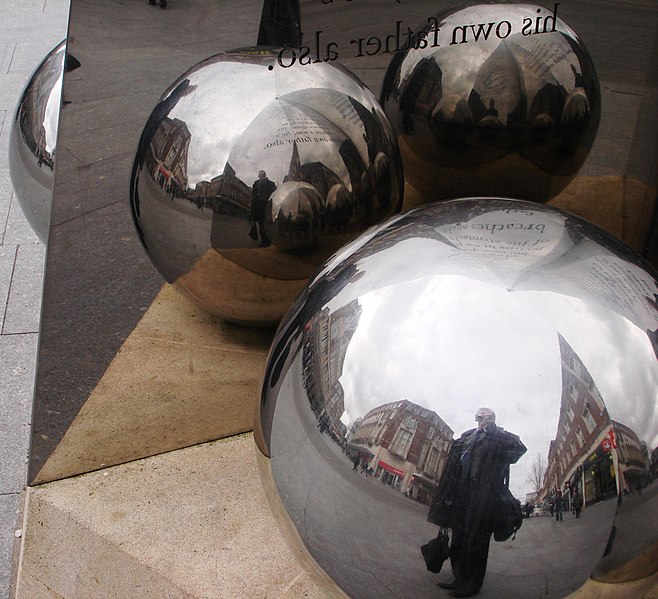File:The Exeter Riddle points elsewhere, or does it^ - geograph.org.uk - 1751700.jpg

Original file (2,687 × 2,448 pixels, file size: 2.22 MB, MIME type: image/jpeg)
Captions
Captions
Summary edit
| DescriptionThe Exeter Riddle points elsewhere, or does it^ - geograph.org.uk - 1751700.jpg |
English: The Exeter Riddle points elsewhere, or does it? The Exeter Riddle echoes the work of Pol Bury in his fountain sculpture amongst the Buren Columns in the Palais Royale in Paris. In the fountain sculpture, (also public art), the stainless steel balls are composed from two independently moving hemispheres which reflect the ancient buildings and the modern world. They too, by the nature of their shape and their reflective surfaces, show us a frozen moment in time if we look into them.
Michael Fairfax's sculpture shares in this enigmatic characteristic, giving us our moment in serial time. The steel balls act like extreme wide angle lenses, wrapping us up in a 360 degree environment, converting our existence into a microcosm. If you study the image, you will notice that each ball reflects a different microcosm covering different elements in a different "mise en scene" including reflections of other steel balls containing their own reflections. A more obviously enigmatic aspect is that the sculpture is inscribed with riddles which are reflected in planes of the sculpture to assist us to "read" them in a conventional fashion, from left to right, horizontally across the "page". But perhaps we are meant to read them in their reverse image to challenge our minds to wander to other mirrors in other works of art that shift our sense of perception and our existence. Jean Cocteau's "Orphee" springs to mind. It is good to have a Sphinx-like presence in the high street, over and beyond time. |
| Date | |
| Source | From geograph.org.uk |
| Author | Tom Jolliffe |
| Attribution (required by the license) InfoField | Tom Jolliffe / The Exeter Riddle points elsewhere, or does it? / |
InfoField | Tom Jolliffe / The Exeter Riddle points elsewhere, or does it? |
| Camera location | 50° 43′ 29″ N, 3° 31′ 50″ W | View this and other nearby images on: OpenStreetMap |
|---|
| Object location | 50° 43′ 29″ N, 3° 31′ 50″ W | View this and other nearby images on: OpenStreetMap |
|---|
Licensing edit

|
This image was taken from the Geograph project collection. See this photograph's page on the Geograph website for the photographer's contact details. The copyright on this image is owned by Tom Jolliffe and is licensed for reuse under the Creative Commons Attribution-ShareAlike 2.0 license.
|
- You are free:
- to share – to copy, distribute and transmit the work
- to remix – to adapt the work
- Under the following conditions:
- attribution – You must give appropriate credit, provide a link to the license, and indicate if changes were made. You may do so in any reasonable manner, but not in any way that suggests the licensor endorses you or your use.
- share alike – If you remix, transform, or build upon the material, you must distribute your contributions under the same or compatible license as the original.
{
File history
Click on a date/time to view the file as it appeared at that time.
| Date/Time | Thumbnail | Dimensions | User | Comment | |
|---|---|---|---|---|---|
| current | 00:48, 6 March 2011 |  | 2,687 × 2,448 (2.22 MB) | GeographBot (talk | contribs) | == {{int:filedesc}} == {{Information |description={{en|1=The Exeter Riddle points elsewhere, or does it? The Exeter Riddle echoes the work of Pol Bury in his fountain sculpture amongst the Buren Columns in the Palais Royale in Paris. In the fountain sculp |
You cannot overwrite this file.
File usage on Commons
There are no pages that use this file.
Metadata
This file contains additional information such as Exif metadata which may have been added by the digital camera, scanner, or software program used to create or digitize it. If the file has been modified from its original state, some details such as the timestamp may not fully reflect those of the original file. The timestamp is only as accurate as the clock in the camera, and it may be completely wrong.
| Camera manufacturer | SONY |
|---|---|
| Camera model | DSC-W100 |
| Exposure time | 1/320 sec (0.003125) |
| F-number | f/5.6 |
| ISO speed rating | 125 |
| Date and time of data generation | 14:18, 12 March 2010 |
| Lens focal length | 7.9 mm |
| File change date and time | 14:18, 12 March 2010 |
| Y and C positioning | Co-sited |
| Exposure Program | Normal program |
| Exif version | 2.21 |
| Date and time of digitizing | 14:18, 12 March 2010 |
| Image compression mode | 8 |
| APEX exposure bias | 0 |
| Maximum land aperture | 3 APEX (f/2.83) |
| Metering mode | Pattern |
| Light source | Unknown |
| Flash | Flash did not fire, compulsory flash suppression |
| Color space | sRGB |
| Custom image processing | Normal process |
| Exposure mode | Auto exposure |
| White balance | Auto white balance |
| Scene capture type | Standard |
| Contrast | Normal |
| Saturation | Normal |
| Sharpness | Normal |